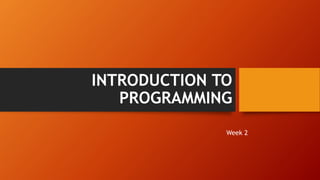
week 2 - INTRO TO PROGRAMMING.pptx
- 2. Topic •Programming Evolution •Programming Language Paradigm •Translators
- 3. Programming Language Evolution 1. Machine Language • Machine language is a collection of binary digits or bits that the computer reads and interprets. 2. Assembly Language • Uses symbolic operation code to represent the machine operation code. 3. High level Language • Uses English like statements
- 4. Programming Language Evolution • High level language Example : C++ Add 2 numbers #include<iostream> Void main() { int a, b, c; cout <<“Enter two numbers:n”; cin >>a; cin >>b; c = a+b; cout <<“Sum of 2 numbers is {0}”, c); } • Machine Language Example: check if low-order 4 bits of value in reg 1 = 0 2000 load load zero into reg 0 220F load load string 00001111 into reg 2 8312 AND c(reg 1) AND c(reg 2) —> reg 3 — masking B3XY JMP jump to address XY if c(reg 3) = c(reg 0) • Assembly Language Example : Add 2 numbers name "add" mov al, 5 ; bin=00000101b mov bl, 10 ; hex=0ah or bin=00001010b add bl, al ; 5 + 10 = 15 (decimal) or hex=0fh or bin=00001111b
- 5. Programming Language Paradigm • Programming paradigm is a fundamental style of computer programming • Programming paradigm is an approach to solving programming problems. • Programming paradigm that describes computation in terms of statements that change a program state. • It defines sequences of commands for the computer to perform • For example, • X := X+2 • Assignment changes the value at a location. • A program execution generates a sequence of states
- 6. Programming Language Paradigm Common programming paradigms: 1.Imperative or Procedural Programming 2.Object-Oriented Programming 3.Functional Programming 4.Logic Programming
- 8. Programming Language Paradigm 1. Imperative or Procedural Programming • a program is a series of statements containing variables. • Program execution involves changing the memory contents of the computer continuously. • Example of imperative languages are: C, FORTRAN, Pascal, COBOL etc • Advantages low memory utilization relatively efficient the most common form of programming in use today. • Disadvantages difficulty of reasoning about programs difficulty of parallelization. Tend to be relatively low level
- 9. Programming Language Paradigm 2. Object-Oriented Programming • A program in this paradigm consists of objects which communicate with each other by sending messages • Example object oriented languages include: Java, C#, Smalltalk, etc • Advantages Conceptual simplicity Models computation better Increased productivity • Disadvantages Can have a steep learning curve, initially Doing I/O can be cumbersome
- 10. Programming Language Paradigm 3. Functional Programming • A program in this paradigm consists of functions and uses functions in a similar way as used in mathematics • Program execution involves functions calling each other and returning results. There are no variables in functional languages • Example functional languages include: ML, MirandaTM, Haskell • Advantages Small and clean syntax Better support for reasoning about programs They allow functions to be treated as any other data values. They support programming at a relatively higher level than the imperative languages • Disadvantages Difficulty of doing input-output Functional languages use more storage space than their imperative cousins
- 11. Programming Language Paradigm 4. Logic Programming • A program in the logic paradigm consists of a set of predicates and rules of inference. Predicates are statements of fact like the statement that says: water is wet. • Rules of inference are statements like: If X is human then X is mortal. The predicates and the rules of inference are used to prove statements that the programmer supplies. • Example: Prolog • Advantages Good support for reasoning about programs Can lead to concise solutions to problems • Disadvantages Slow execution Limited view of the world That means the system does not know about facts that are not its predicates and rules of inference. Difficulties in understanding and debugging large programs
- 12. Translators • A translator is a computer program that performs the translation of a program written in a given programming language into a functionally equivalent program in a different ways computer language, without losing the functional or logical structure of the original code (the "essence" of each program) • Programs must be translated into machine codes before execution
- 13. Translators Types of translator 1. Assembler 2. Compiler 3. interpreter
- 14. Translators 1. Assembler • Assembler is a computer program which is used to translate program written in Assembly Language in to machine language. • A program which translates an assembly language program into a machine language program • Assembler are used to convert assembly language code into machine code.
- 15. Translators 2. Compiler • A compiler is a program that translates a programme written in HLL to executable machine language • It is a program which translates a high level language program into a machine language program. • A compiler is more intelligent than an assembler. • Compilers are used to convert high level languages (like C, C++ ) into machine code
- 16. Translators 3. Interpreter • Interpreter translates each instruction, executes it and then the next instruction is translated and this goes on until end of the program. • An interpreter is a program which translates statements of a program into machine code. • It translates only one statement of the program at a time. • An interpreter is a computer program which executes a statement directly (at runtime)